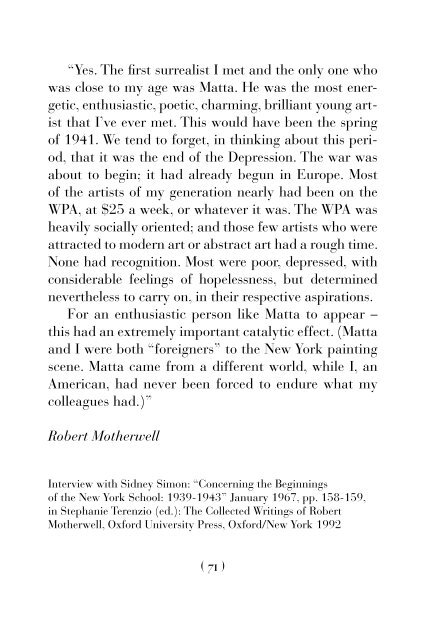Matta-Duchamp
Illustrated catalog featuring full page color illustrations and rare documentary photographs. Published by Galerie Gmurzynska in June 2018 to accompany a special cabinet exhibition at Art Basel 2018. The book includes texts by Professor Dawn Adès and Norman Rosenthal. It coincides with a broader re-evaluation of the importance of Matta internationally as well as of the influence of Duchamp on the work of 20th century artists. Edited and introduced by Krystyna Gmurzynska and Mathias Rastorfer. Essays by Dawn Adès and Norman Rosenthal. Historic interview excerpt by Robert Motherwell. 90 pages with 7 illustrations. Softcover. ISBN: 978-3-905792-09-6
Illustrated catalog featuring full page color illustrations and rare documentary photographs.
Published by Galerie Gmurzynska in June 2018 to accompany a special cabinet exhibition at Art Basel 2018. The book includes texts by Professor Dawn Adès and Norman Rosenthal. It coincides with a broader re-evaluation of the importance of Matta internationally as well as of the influence of Duchamp on the work of 20th century artists.
Edited and introduced by Krystyna Gmurzynska and Mathias Rastorfer.
Essays by Dawn Adès and Norman Rosenthal.
Historic interview excerpt by Robert Motherwell.
90 pages with 7 illustrations.
Softcover.
ISBN:
978-3-905792-09-6
You also want an ePaper? Increase the reach of your titles
YUMPU automatically turns print PDFs into web optimized ePapers that Google loves.
“Yes. The first surrealist I met and the only one who<br />
was close to my age was <strong>Matta</strong>. He was the most energetic,<br />
enthusiastic, poetic, charming, brilliant young artist<br />
that I’ve ever met. This would have been the spring<br />
of 1941. We tend to forget, in thinking about this period,<br />
that it was the end of the Depression. The war was<br />
about to begin; it had already begun in Europe. Most<br />
of the artists of my generation nearly had been on the<br />
WPA, at $25 a week, or whatever it was. The WPA was<br />
heavily socially oriented; and those few artists who were<br />
attracted to modern art or abstract art had a rough time.<br />
None had recognition. Most were poor, depressed, with<br />
considerable feelings of hopelessness, but determined<br />
nevertheless to carry on, in their respective aspirations.<br />
For an enthusiastic person like <strong>Matta</strong> to appear –<br />
this had an extremely important catalytic effect. (<strong>Matta</strong><br />
and I were both “foreigners” to the New York painting<br />
scene. <strong>Matta</strong> came from a different world, while I, an<br />
American, had never been forced to endure what my<br />
colleagues had.)”<br />
Robert Motherwell<br />
Interview with Sidney Simon: “Concerning the Beginnings<br />
of the New York School: 1939-1943” January 1967, pp. 158-159,<br />
in Stephanie Terenzio (ed.): The Collected Writings of Robert<br />
Motherwell, Oxford University Press, Oxford/New York 1992<br />
( 71 )

















